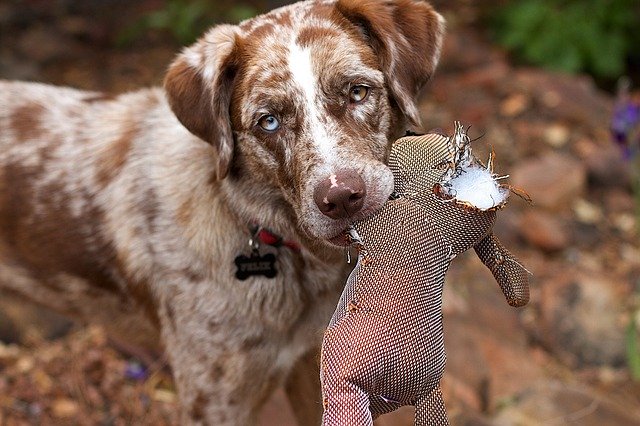There have been many changes in our lives associated with COVID-19 and our pets are experiencing those changes as well. For many pets, having people home all of the time is a dramatic departure from normal/expected daily routine and this can have significant consequences. The following are some considerations to keep in mind for our canine and feline companions.
Canine Companions
Dogs can struggle with the change in structure and routine, especially dogs who are anxious. Many dogs are used to a predictable routine associated with the work routine of their owners, which has changed dramatically in many homes associated with their owners working from home or working altered hours outside of the house. Many dogs are also used to having quiet/down time throughout the day, which may no longer be the case with adults and/or children home around-the-clock. Additionally, there is potentially significantly more environmental stimulation in your neighborhood/community. This can be associated with more people home day-to-day and the sounds associated with their presence in their home – household appliances being run at different times of day than “normal”, people speaking on phone/teleconference calls, televisions being on at altered times/different channels, etc. There may also be more children/adults out on porches, in backyards or playing on the sidewalk/in the streets. Additionally, there may be more people taking their dogs for walks than were taken for daily exercise walks prior to the coronavirus.
Dogs that are social and enjoy the presence of people and dogs in their neighborhood may be struggling with not being allowed to engage with the people/dogs in the neighborhood/passing the house. This may be exacerbated if there is more continuous visual and auditory stimulation of people and dogs outside of their home and while on walks then “usual”. You may be observing anxious or frustration behaviors from these social dogs in response to not being allowed to engage with others due to social distancing guidelines. It is also important to remember that not all dogs are social with other dogs and unfamiliar/less familiar people. For those of our canine companions who struggle with fear and anxiety associated with the presence of other dogs or unfamiliar people, having to continuously track those stimuli outside of their home and not having “safe” times to go for walks can be life altering. Many anxious dogs benefit from walking at times there is less stimulation from people, animals or the environment. Many neighborhoods/communities previously had predictable times where owners of anxious animals could provide their canine companion with less stimulating walks, however, in some places this access to predictable “quiet” times has been lost.
Dogs who are used to having routine social interactions with other dogs at daycare, but do not have access to other dogs at home, may be struggling without the physical and mental exercise provided by routine dog-dog play. This may be compounded by the fact that due to social distancing guidelines, dogs should not be interacting with other dogs on walks, therefore many dogs may have lost all access to dog play/interactions that they would have had regularly prior to the coronavirus. Conversely, dogs who need breaks from their house mates to live together successfully, which would “normally” be provided by those dogs being separated while home alone or one dog going to daycare while the other stays home, may be struggling with significantly more time together. This is especially true if there is a significant age/play style/social need/ability to read social cues difference between house mate dogs.
Additionally, for dogs who struggle with being home alone or being confined in small spaces (such as a crate), going for weeks-to-months without having to experience these anxiety producing interactions can potentially exacerbate their anxiety in response to departures/time in the crate when their owner’s schedules return to “normal”. Ensuring your dog(s) continue to have positive departures/crate time benefits their continued positive learning that being alone/confined is not dangerous/threatening. Always pair departures/crate time with pleasure for your canine companion, preferably in the form of a longer-lasting food toy/chew/treat (please speak with your vet about appropriate options and safety of use in multi-dog households).
Mental stimulation provided by food toys, food puzzles, foraging games and training sessions can be helpful. Combined physical/mental exercise can also be beneficial – using a Flirt Pole, working walks or play sessions (asking for multiple different commands intermittently while walking or playing with your canine companion), hide-and-seek (for people, toys or treats) in the house/yard or encouraging tag/tug/wrestle play (as long as they can be done safely, please speak with your vet about any concerns about safety of these interactions with your dog for either physical or behavioral reasons). Additionally, ensuring our canine companions can have some time alone, as long as separation/confinement is not a source of stress, in a quiet place can provide them with access to an ability to relax and rest that may not be available to them if they are constantly tracking environmental stimuli from within the house. It is recommended you use a room/crate (as is appropriate for your individual dog) with classical music and white noise playing and provide a longer-lasting food toy/chew/treat (please speak with your vet about appropriate options and safety of use in multi-dog households) to promote relaxation and build a positive association with going away in this quiet space. Ensuring our canine companions experience pleasure through the use of treats or toy play preemptively in situations where they would normally be anxious, fearful or overstimulated can also be beneficial in preserving their mental health at this time when many more situations may be anxiety or fear inducing or when they are more overstimulated than “usual”.
Feline Companions
Cats who live in houses with owners who routinely leave the home to work can be stressed by the change in routine associated with owners being home more frequently/all of the time. This stress can result in altered interactions between house mates and altered litter box behaviors. Stress can contribute to Feline Lower Urinary Tract Disease (FLUTD) [also known as Feline Interstitial/Idiopathic Cystitis (FIC)], which can result in inappropriate elimination and urinary obstruction. Urinary obstruction is life threatening, if your cat is straining in the box or unable to urinate, it should be seen by a veterinarian immediately.
Cats may benefit from time alone from house mate felines, canines and humans as more frequent interactions, especially if those interactions are unsolicited, can be a source of stress for some cats. Providing cats with safe, elevated resting spaces throughout the house and at least one safe room that the resident dog(s) and people do not routinely enter can be beneficial in promoting emotional and physical health in our feline companions. Cats can also benefit from classical music and pheromone enrichment in both common areas and their designated safe space. Feliway® is a synthetic version of the facial pheromone deposited when cats bunt. It comes as a spray and a plug-in diffuser, both of which can be used in common areas and in a safe haven room to help the cat feel comfortable in that space. Feliway MultiCat® is a synthetic version of the feline appeasing pheromone which helps promote bonding between cats and can be used in spaces feline house mates are likely to share space ,to promote continued positive interactions between house mate cats.
To help prevent stress directly associated with elimination, you want to consider the box, the substrate (litter) and the location. During “normal” daily life, cats will generally use a litter box even if it is not in an ideal location, providing a preferred substrate or cleaned on an appropriate schedule, however, if your cat is stressed, “non-ideal” litter boxes can be an added source of stress. Please ensure you have at least one more litter box than the number of cats you have in your home and remember that covered litter boxes that are not cleaned appropriately can resemble the equivalent of a Porta-Potty for our feline house mates. Boxes should be large enough that your cat can comfortably posture to urinate and defecate and can cover their elimination. Litter should be scooped at least once daily and the entire box should be changed at least once every 2-3 weeks. Please try and use a type/brand of litter you know your cat readily uses for elimination. Unless your cat is having a litter box issue and your vet has recommended a change in litter, now is likely not the best time introduce a new cat litter. Litter boxes should not all be in the same space (such as a corner of the basement), or they will serve as one large litter box, rather than multiple individual boxes. Remember that many of the areas we chose for litter box placement are not necessarily enticing to cats. Your cat may have reservations about using a box that is near a loud mechanical device, in an area where access to/escape from the box can be blocked by another cat or dog or in an area of the house that you never use. If you cat is already stressed about changes in routine or environment, concerns about their litter box location could contribute to not eliminating in that box.
Remember that cats may want to sit with us and can be very affectionate when they solicit interactions, but they may not want to be engaged as frequently through petting/touch/hug interactions as we are currently offering due to the comfort these interactions bring to use. Finding other ways to engage your cat may be of benefit for both you and your feline companion. Cats benefit from environmental enrichment and mental exercise to help reduce stress and meet social needs. Please consider multiple short play sessions with their favorite toys daily and providing access to “kitty tv” in the form of bird feeders or squirrel feeding stations outside of windows that are accessible to your feline companions or cat enrichment videos on platforms such as YouTube (for those cats who watch television). Some cats enjoy mechanized toys and they can also benefit from the mental stimulation provided by food/foraging toys (which can be fun for us to watch). Many cats prefer elevated resting spaces (cat beds on window sills, cat trees, the top of the couch, bookshelves, etc) and often they will choose a warm spot to settle/relax (in the sun, on a heating pad, on a lap) and may want to just sit with you, rather than be engaged.
Please reach out to your veterinarian with any questions or concerns about the mental and emotional wellbeing of your canine or feline companion, just as you would for questions and concerns around physical wellbeing. If you feel your companion is experiencing changes in their response to environmental stimuli or current living situations that are affecting their quality of life, they may also benefit from a behavioral medicine visit with a veterinary behaviorist to make a specific plan to help them be more comfortable in their own skin during this unprecedented time.
Author: Dr. Shana Gilbert-Gregory

